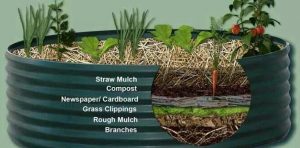Creating A Kitchen Garden
It doesn’t matter what kind of house and space you have, it’s possible for you to grow your own fresh and yummy produce.
In creating a kitchen garden, you need to first figure out what kind of garden bed you’re dealing with. Is it an existing one, a raised one, or a no-dig one? The following are some pointers to take into account depending on what kind of bed you have.
- Existing garden bed – Well before you convert into a vegetable garden, make sure you dig the soil over to about 100 mm and mix in a lot of organic matter like compost. The compost should be about a third of the soil. Don’t do it when the soil is too wet so it doesn’t get compacted. If you’re working with clay soil, sprinkle some gypsum over it before adding compost.

Raised Garden Bed
- Raised garden bed – If you’re creating a raised bed, make sure that it allows easy pedestrian navigation so that there’ll be no problem making it a permanent feature. On the technical side, place it where it gets lots of sun, make the walls at least 30 cm high, and in case the bed has a base, put in drainage holes.
- No-dig garden bed – You build one by lining the ground with newspaper or cardboard, layering pieces of it before adding soil mix or compost. On top of this, alternate layers of fine and coarse compostable materials. A good combination consists of separate layers of pea straw, aged cow manure and compost. To plant in this kind of garden bed, make a small hole in the top compost layer and fit the seedling in it. Water, mulch, and top up with more aged manure and compost.
What about containers? Here are some pointers to remember:
- Don’t use garden soil for containers. It has microbes, fungi, and other living creatures that are harmless in the ground, but can do damage to potted plants. Garden soil also drains poorly and breaks down fast in pots. Organic potting mix is the general recommendation, although it needs to be replaced every so often. Don’t forget to add mulch to the top for better water retention and weed growth prevention.
- When planning the layout of your container garden, you need to take into account not only the plants’ needs, but your own as well. You’ll want them closer to the house for easier watering, weeding harvesting, etc. The beauty in using containers is that they can be moved around, so do so based on their sunlight needs. You might want to place your containers in clusters to achieve better visual impact, make watering easier, and create biodiversity. If you don’t have a lot of space, you can plan a vertical garden instead.
Keep all these tips in mind when creating a kitchen garden and soon you’ll be harvesting your own produce.

No-dig Garden Bed
Contact Jim’s Mowing on 0800 454 654 or book online.


